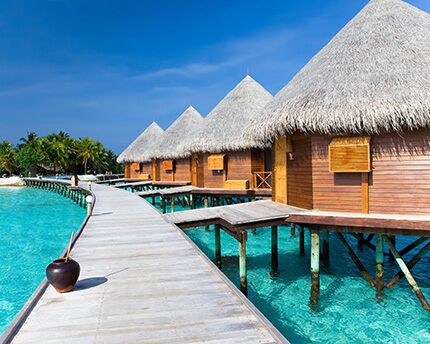When is the best time to visit the Maldives? If you consider the average temperature, you can visit the Maldives any time because this paradise archipelago of around 1,200 islands offers sunshine and warm temperatures all year round. However, the monsoon season, which runs from May to October, should be taken into account, as well as the months with the highest chance of rainfall and strong winds (June and July are the wettest months).
Nevertheless, if you do not mind suffering a bit more from the weather in exchange for a cheaper deal on flights and accommodation, the off-peak season (May to November) is the ideal time to get the best discounts. If you want to see certain marine species such as whale sharks and manta rays, there are months that are more favourable than others for spotting these spectacular marine animals.
Best time to visit the Maldives
The average temperature in the Maldives is rarely less than 25°C: this is due to the mild tropical climate that is typical of this part of the Indian Ocean.

When is the best time to visit the Maldives if the average temperature is high, there is an average of six to eight hours of sunshine a day and the seawater maintains a constant temperature of 27°C to 29°C? If you are looking for the best weather, go during the peak season (December to February) or mid-season (March to April). May to October is monsoon season while June and July tend to be the rainiest months but, if your goal is to see whale sharks or manta rays, August to November are the best months.
On the other hand, for those who want to scuba dive, snorkel or even surf, December to April are the months when there is less chance of rainfall. It is also a good season for diving due to the currents coming from the north-east and offering clearer waters with better visibility.
Rainy and monsoon months
Most of the off-peak season in the Maldives coincides with the rainy and monsoon months (May to October). If you do not mind getting wet or suffering strong gusts of wind, this is the best time to find the cheapest flights and accommodation during the year.

Monsoons are seasonal winds that occur when the earth cools and warms faster than water and are caused by the shifting of the intertropical or equatorial convergence zone – the region of the earth where the trade winds of the northern hemisphere converge with those of the southern hemisphere.
There are two monsoon periods in the Maldives: the ‘dry’ or winter monsoon, which runs from November to March and is the ‘coldest’ time of the year; and the ‘wet’ or summer monsoon, which runs from May to October and there is heavy rainfall, heat and humidity.
Summer monsoon
From May to October is the ‘wet’ or summer monsoon season, when the wind comes from the south-east. Heat, humidity, strong winds and a lot of rain are the characteristics of this period of the year in the Maldives.
Heavy rains usually fall in a short period of time. Afterwards, the sun comes out, temperatures rise sharply and there is a lot of humidity.

Winter monsoon
From November to April is the ‘dry’ or winter monsoon season, when the wind comes from the north-east. This period is characterised by moderate temperatures of 26°C-29°C, low humidity, little rainfall and sunny days.
For many, this is the best time to travel to the Maldives, although it is also the most expensive since it is the peak season (December to February). If you want to spend Christmas in this paradise in the middle of the Indian Ocean, you should book in advance.










































































